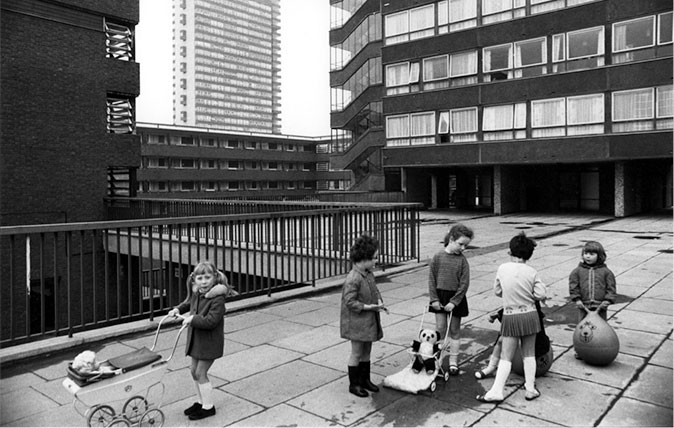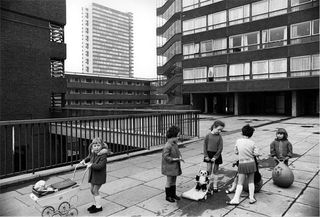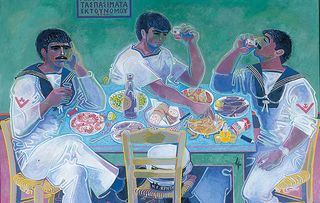In Focus: A moment in time capturing the gulf between architects' dreams and residents' realities
Tony Ray-Jones was one of a generation of photographers who chronicled life in Britain in the 1960s and 1970s, demonstrating the gulf between the dreams of town planners and the reality for the residents. Chloe-Jane Good takes a look at one of his most famous images.


Children play outdoors on an elevated concrete walkway of a housing estate. Metal railings, slabbed planes, residential blocks and a tower surround them. Two vertical rectangles of sky between blocks and tower are visible, but it is a characterless, overcast and impenetrable sky.
Patches of rainwater lie on the ground. There is no greenery in view and the hard, sparse surfaces contrast to the children grouped in play. One girl walks away from the others with a doll in a toy pram and she is alone and stiff in addressing the camera.
In 1970, Architectural Review commissioned street photographer Tony Ray-Jones (1941 - 1972) to document people living on housing estates in Britain to illustrate a special issue on housing as part of the magazine’s ‘Manplan’ series. Pepys Estate, Deptford, London: children playing on a raised walkway, 1970, is one of those photographs. It is now on view until March 3, 2019 at the Wellcome Collection in London, part of an exhibition entitled 'Living with Buildings' which explores the positive and negative ways that urban planning shapes lives and health.
‘Manplan’ was initiated by Hubert de Cronin Hastings, the then chairman of the Architectural Press and editor of Architectural Review. The series of eight issues was a brave and radical look at town planning and its effects on real people and their everyday lives. Steve Parnell, an architectural critic and historian, praised the series in a 2014 article in Architectural Review: ‘Manplan focused not on buildings, but on people, and not as individuals, but as a society.’
Prior to ‘Manplan’, the magazine employed mainly staff photographers and the customary style was formal and architectural. The photographers used large format cameras for high definition and controlled compositions. White space, blue skies and the absence of people – except for those that were staged to show scale – were the accepted conventions of the genre.
Architectural photographer John Donat, in a lecture he delivered at RIBA in 1967, criticised this traditional architectural photography, attacking its detachment from the reality of a building in favour of decontextualised forms and details. 'Why does it never rain in the Architectural Review?' he pondered.
Hastings' Manplan series took up the implicit challenge, turning away from standard depictions and instead taking a humanist approach, challenging town planning and putting under scrutiny cases where it had impacted negatively on people’s lives. He looked to photojournalists and street photographers who were capturing British life as it occurred.
Sign up for the Country Life Newsletter
Exquisite houses, the beauty of Nature, and how to get the most from your life, straight to your inbox.
These photographers, working in the moment, chose not to be hindered by large cameras and instead used fast black and white 35mm film, producing gritty images. The prominence of black in the illustrations was heightened by the design of the magazine spreads which featured unusual amounts of black space printed using a custom matt black ink.
Tony Ray-Jones was one of these trailblazers, a wonderful photographer who, despite his short life (he died from leukaemia at age 30), left a profound legacy. He laid the groundwork for many important British photographers working today, including Martin Parr, who has been particularly inspired by the English seaside resort pictures.
Parr went through the entire Ray-Jones archive in preparation to pay tribute in a joint exhibition in 2013 at London’s Science Museum, which holds in its collection around 2,700 contact sheets and 1,700 35mm rolls of film taken by Ray-Jones.
In the early 1960s Ray-Jones left England to study at Yale University School of Art and went on to New York where he was influenced by American street photographers like Garry Winogrand. On his return to Britain in late 1965, he brought his experience in America to document English way of life as he saw it before it disappeared. The timing was right for urban documentary.
Formally opened in 1966, the Pepys Estate had been expected to improve the lives of many. Instead, when Ray-Jones visited, he found himself in a dystopian landscape demonstrating the shortcomings of the recently-built social housing schemes.

In Focus: The stunning collection of philanthropist Samuel Courtald, including Cézanne's most groundbreaking works
Courtald's collection of Impressionist works returns to The National Gallery for the first time in 70 years. Chloe-Jane Good takes

In Focus: The charmed life of Paddy Leigh Fermor and friends in Greece
The iconic writer Paddy Leigh Fermor and two of his friends in Greece – both artists, one a local man and

In Focus: The plantsman-turned-artist who found art in flowers, and painted from corner to corner
Cedric Morris's striking still life images have been largely forgotten for three decades, but three new shows are ending that

From hidden swords to Sting, everything you need to know about walking canes
Sported by traditional types, the walking cane is both stylish, practical – and sometimes deadly.
-
 The century-old enamelling technique used to create Van Cleef's lucky ladybird brooch — which has something in common with Country Life
The century-old enamelling technique used to create Van Cleef's lucky ladybird brooch — which has something in common with Country LifeThe technique used in the jeweller's Geneva workshop has been put to good use in its latest creation.
By Hetty Lintell Published
-
 ‘The best sleep in the sky’: What it’s like to fly in United’s Polaris cabin, approved by American icon Martha Stewart
‘The best sleep in the sky’: What it’s like to fly in United’s Polaris cabin, approved by American icon Martha StewartUnited’s Business Class cabin goes by the name Polaris and Martha Stewart is a fan. So, how does it fare?
By Rosie Paterson Published